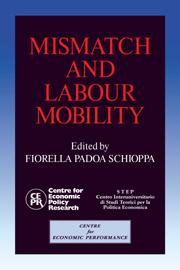Book contents
- Frontmatter
- Contents
- List of figures
- List of tables
- Preface
- Acknowledgements
- List of conference participants
- 1 A cross-country comparison of sectoral mismatch in the 1980s
- 2 Mismatch: a framework for thought
- Discussion
- 3 Match and mismatch on the German labour market
- Discussion
- 4 Mismatch in Japan
- Discussion
- 5 Mismatch and internal migration in Spain, 1962–86
- Discussion
- 6 Regional inequalities, migration and mismatch in Italy, 1960–86
- Discussion
- 7 Skill shortages and structural unemployment in Britain: a (mis)matching approach
- Discussion
- 8 Labour market tightness and the mismatch between demand and supply of less-educated young men in the United States in the 1980s
- Discussion
- 9 Skill mismatch, training systems and equilibrium unemployment: a comparative institutional analysis
- Discussion
- 10 Unemployment, vacancies and labour market programmes: Swedish evidence
- Discussion
- 11 Mismatch and labour mobility: some final remarks
- Index
Discussion
Published online by Cambridge University Press: 05 October 2010
- Frontmatter
- Contents
- List of figures
- List of tables
- Preface
- Acknowledgements
- List of conference participants
- 1 A cross-country comparison of sectoral mismatch in the 1980s
- 2 Mismatch: a framework for thought
- Discussion
- 3 Match and mismatch on the German labour market
- Discussion
- 4 Mismatch in Japan
- Discussion
- 5 Mismatch and internal migration in Spain, 1962–86
- Discussion
- 6 Regional inequalities, migration and mismatch in Italy, 1960–86
- Discussion
- 7 Skill shortages and structural unemployment in Britain: a (mis)matching approach
- Discussion
- 8 Labour market tightness and the mismatch between demand and supply of less-educated young men in the United States in the 1980s
- Discussion
- 9 Skill mismatch, training systems and equilibrium unemployment: a comparative institutional analysis
- Discussion
- 10 Unemployment, vacancies and labour market programmes: Swedish evidence
- Discussion
- 11 Mismatch and labour mobility: some final remarks
- Index
Summary
One of the standard comments that discussants of conference papers are wont to make is that the study under consideration looks exciting, but that further reflection reveals the approach to be nothing new. The study by Edin and Holmlund merits the opposite assessment: the study is not exciting, but further reflection reveals matters of importance. In this discussion, I will not quibble about the appropriateness of the authors' data and econometric tests; rather, I will concentrate on two significant issues raised by their study.
The first concerns the authors' classification of labour market states. It is very common in the theory of labour markets (and in much of the empirical work in this area as well) to distinguish only between two states: employment (E) and unemployment (U): in other words, workers who are not employed are assumed to be unemployed. There is, however, a growing body of evidence suggesting that this twofold classification overlooks some important alternatives:
(a) The state of being ‘out of the labour force’ (OLF) is important in the sense that the flows between OLF and E, and between OLF and U, often are of the same order of magnitude as the flows between E and U.
(b) The employment state (E) is far from homogeneous. As an initial step, it is often useful to distinguish between ‘primary’ and ‘secondary’ employment, with the former characterised by comparatively higher wages and more job security than the latter. The difference between the present value of income from the primary and secondary sectors is often greater than the difference between the present value of income from secondary employment and unemployment. Similarly, it is also useful to distinguish between full-time and part-time employment.
- Type
- Chapter
- Information
- Mismatch and Labour Mobility , pp. 449 - 452Publisher: Cambridge University PressPrint publication year: 1991



